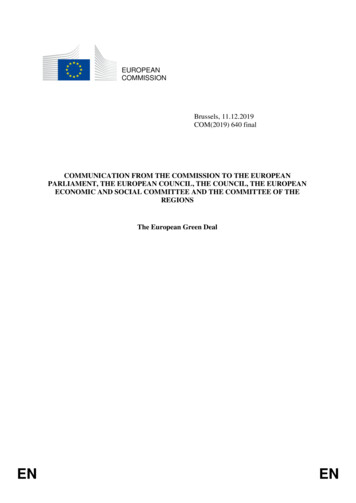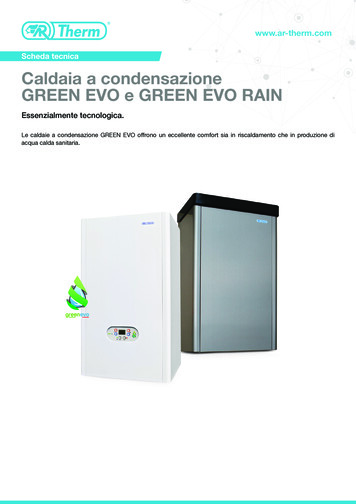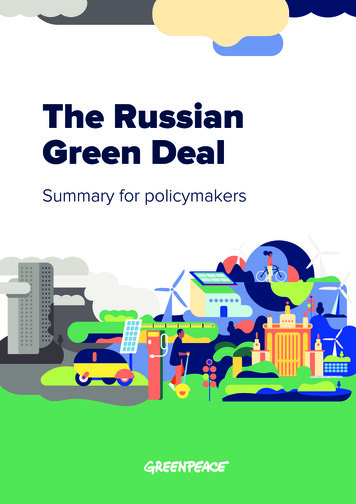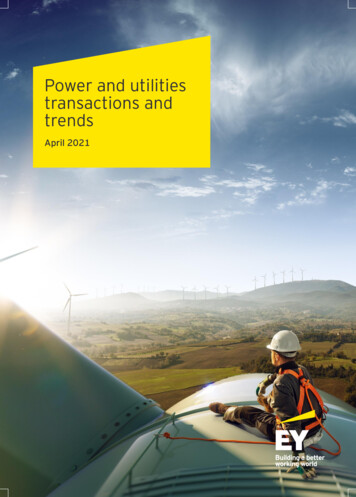
Transcription
EUROPEANCOMMISSIONBrussels, 11.12.2019COM(2019) 640 finalCOMMUNICATION FROM THE COMMISSION TO THE EUROPEANPARLIAMENT, THE EUROPEAN COUNCIL, THE COUNCIL, THE EUROPEANECONOMIC AND SOCIAL COMMITTEE AND THE COMMITTEE OF THEREGIONSThe European Green DealENEN
1.INTRODUCTION - TURNING AN URGENT CHALLENGE INTO A UNIQUE OPPORTUNITYThis Communication sets out a European Green Deal for the European Union (EU)and its citizens. It resets the Commission’s commitment to tackling climate andenvironmental-related challenges that is this generation’s defining task. The atmosphereis warming and the climate is changing with each passing year. One million of the eightmillion species on the planet are at risk of being lost. Forests and oceans are beingpolluted and destroyed1.The European Green Deal is a response to these challenges. It is a new growth strategythat aims to transform the EU into a fair and prosperous society, with a modern,resource-efficient and competitive economy where there are no net emissions ofgreenhouse gases in 2050 and where economic growth is decoupled from resourceuse.It also aims to protect, conserve and enhance the EU's natural capital, and protectthe health and well-being of citizens from environment-related risks and impacts. Atthe same time, this transition must be just and inclusive. It must put people first, and payattention to the regions, industries and workers who will face the greatest challenges.Since it will bring substantial change, active public participation and confidence in thetransition is paramount if policies are to work and be accepted. A new pact is needed tobring together citizens in all their diversity, with national, regional, local authorities, civilsociety and industry working closely with the EU’s institutions and consultative bodies.The EU has the collective ability to transform its economy and society to put it on amore sustainable path. It can build on its strengths as a global leader on climate andenvironmental measures, consumer protection, and workers’ rights. Delivering additionalreductions in emissions is a challenge. It will require massive public investment andincreased efforts to direct private capital towards climate and environmental action, whileavoiding lock-in into unsustainable practices. The EU must be at the forefront ofcoordinating international efforts towards building a coherent financial system thatsupports sustainable solutions. This upfront investment is also an opportunity to putEurope firmly on a new path of sustainable and inclusive growth. The EuropeanGreen Deal will accelerate and underpin the transition needed in all sectors.The environmental ambition of the Green Deal will not be achieved by Europeacting alone. The drivers of climate change and biodiversity loss are global and are notlimited by national borders. The EU can use its influence, expertise and financialresources to mobilise its neighbours and partners to join it on a sustainable path. The EUwill continue to lead international efforts and wants to build alliances with the likeminded. It also recognises the need to maintain its security of supply and competitivenesseven when others are unwilling to act.This Communication presents an initial roadmap of the key policies and measuresneeded to achieve the European Green Deal. It will be updated as needs evolve and the1Sources: (i) Intergovernmental Panel on Climate Change (IPCC): Special Report on the impacts ofglobal warming of 1.5 C; (ii) Intergovernmental Science-Policy Platform on Biodiversity andEcosystem Services: 2019 Global assessment report on biodiversity and ecosystem services; (iii) TheInternational Resource Panel: Global Resources Outlook 2019: Natural Resources for the Future WeWant; (iv) European Environment Agency: the European environment — state and outlook 2020:knowledge for transition to a sustainable Europe2
policy responses are formulated. All EU actions and policies will have to contribute tothe European Green Deal objectives. The challenges are complex and interlinked. Thepolicy response must be bold and comprehensive and seek to maximise benefits forhealth, quality of life, resilience and competitiveness. It will require intense coordinationto exploit the available synergies across all policy areas2.The Green Deal is an integral part of this Commission’s strategy to implement theUnited Nation’s 2030 Agenda and the sustainable development goals3, and the otherpriorities announced in President von der Leyen’s political guidelines4. As part of theGreen Deal, the Commission will refocus the European Semester process ofmacroeconomic coordination to integrate the United Nations’ sustainable developmentgoals, to put sustainability and the well-being of citizens at the centre of economicpolicy, and the sustainable development goals at the heart of the EU’s policymaking andaction.The figure below illustrates the various elements of the Green Deal.Figure 1: The European Green Deal234In line with the findings of the 2020 European environment — state and outlook 2020: knowledge fortransition to a sustainable Europe (European Environment 015/transformingourworldSee Political Guidelines of President elect Ursula von der Leyen: Political guidelines for the nextCommission (2019-2024) – ‘A Union that strives for more: My agenda for Europe’:3
2.TRANSFORMING THE EU’S ECONOMY FOR A SUSTAINABLE FUTURE2.1.Designing a set of deeply transformative policiesTo deliver the European Green Deal, there is a need to rethink policies for clean energysupply across the economy, industry, production and consumption, large-scaleinfrastructure, transport, food and agriculture, construction, taxation and social benefits.To achieve these aims, it is essential to increase the value given to protecting andrestoring natural ecosystems, to the sustainable use of resources and to improving humanhealth. This is where transformational change is most needed and potentially mostbeneficial for the EU economy, society and natural environment. The EU should alsopromote and invest in the necessary digital transformation and tools as these are essentialenablers of the changes.While all of these areas for action are strongly interlinked and mutually reinforcing,careful attention will have to be paid when there are potential trade-offs betweeneconomic, environmental and social objectives. The Green Deal will make consistent useof all policy levers: regulation and standardisation, investment and innovation, nationalreforms, dialogue with social partners and international cooperation. The European Pillarof Social Rights will guide action in ensuring that no one is left behind.New measures on their own will not be enough to achieve the European GreenDeal’s objectives. In addition to launching new initiatives, the Commission will workwith the Member States to step up the EU’s efforts to ensure that current legislation andpolicies relevant to the Green Deal are enforced and effectively implemented.2.1.1. Increasing the EU’s climate ambition for 2030 and 2050The Commission has already set out a clear vision of how to achieve climateneutrality by 20505. This vision should form the basis for the long-term strategy that theEU will submit to the United Nations Framework Convention on Climate Change inearly 2020. To set out clearly the conditions for an effective and fair transition, to providepredictability for investors, and to ensure that the transition is irreversible, theCommission will propose the first European ‘Climate Law’ by March 2020. Thiswill enshrine the 2050 climate neutrality objective in legislation. The Climate Law willalso ensure that all EU policies contribute to the climate neutrality objective and that allsectors play their part.The EU has already started to modernise and transform the economy with the aim ofclimate neutrality. Between 1990 and 2018, it reduced greenhouse gas emissions by23%, while the economy grew by 61%. However, current policies will only reducegreenhouse gas emissions by 60% by 2050. Much remains to be done, starting with moreambitious climate action in the coming decade.By summer 2020, the Commission will present an impact assessed plan to increase theEU’s greenhouse gas emission reductions target for 2030 to at least 50% andtowards 55% compared with 1990 levels in a responsible way. To deliver theseadditional greenhouse gas emissions reductions, the Commission will, by June 2021,review and propose to revise where necessary, all relevant climate-related policy5A Clean Planet for all - A European strategic long-term vision for a prosperous, modern, competitiveand climate neutral economy COM (2018) 7734
instruments. This will comprise the Emissions Trading System6, including a possibleextension of European emissions trading to new sectors, Member State targets to reduceemissions in sectors outside the Emissions Trading System7, and the regulation on landuse, land use change and forestry8. The Commission will propose to amend the ClimateLaw to update it accordingly.These policy reforms will help to ensure effective carbon pricing throughout theeconomy. This will encourage changes in consumer and business behaviour, andfacilitate an increase in sustainable public and private investment. The different pricinginstruments must complement each other and jointly provide a coherent policyframework. Ensuring that taxation is aligned with climate objectives is also essential. TheCommission will propose to revise the Energy Taxation Directive9, focusing onenvironmental issues, and proposing to use the provisions in the Treaties that allow theEuropean Parliament and the Council to adopt proposals in this area through the ordinarylegislative procedure by qualified majority voting rather than by unanimity.As long as many international partners do not share the same ambition as the EU,there is a risk of carbon leakage, either because production is transferred from the EU toother countries with lower ambition for emission reduction, or because EU products arereplaced by more carbon-intensive imports. If this risk materialises, there will be noreduction in global emissions, and this will frustrate the efforts of the EU and itsindustries to meet the global climate objectives of the Paris Agreement.Should differences in levels of ambition worldwide persist, as the EU increases itsclimate ambition, the Commission will propose a carbon border adjustmentmechanism, for selected sectors, to reduce the risk of carbon leakage. This wouldensure that the price of imports reflect more accurately their carbon content. Thismeasure will be designed to comply with World Trade Organization rules and otherinternational obligations of the EU. It would be an alternative to the measures 10 thataddress the risk of carbon leakage in the EU’s Emissions Trading System.The Commission will adopt a new, more ambitious EU strategy on adaptation toclimate change. This is essential, as climate change will continue to create significantstress in Europe in spite of the mitigation efforts. Strengthening the efforts on climateproofing, resilience building, prevention and preparedness is crucial. Work on climateadaptation should continue to influence public and private investments, including onnature-based solutions. It will be important to ensure that across the EU, investors,insurers, businesses, cities and citizens are able to access data and to develop instrumentsto integrate climate change into their risk management practices.678910Consolidated version of Directive 2003/87/EC of the European Parliament and of the Councilestablishing a scheme for greenhouse gas emission allowance trading within the Community andamending Council Directive 96/61/ECRegulation (EU) 2018/842 on binding annual greenhouse gas emission reductions by Member Statesfrom 2021 to 2030 contributing to climate action to meet commitments under the Paris Agreement andamending Regulation (EU) No 525/2013Regulation (EU) 2018/841 on the inclusion of greenhouse gas emissions and removals from land use,land use change and forestry in the 2030 climate and energy framework, and amending Regulation(EU) No 525/2013 and Decision No 529/2013/EUCouncil Directive 2003/96/EC restructuring the Community framework for the taxation of energyproducts and electricitySuch as the free allocation of emission allowances or compensation for the increase in electricity costs5
2.1.2. Supplying clean, affordable and secure energyFurther decarbonising the energy system is critical to reach climate objectives in2030 and 2050. The production and use of energy across economic sectors account formore than 75% of the EU’s greenhouse gas emissions. Energy efficiency must beprioritised. A power sector must be developed that is based largely on renewablesources, complemented by the rapid phasing out of coal and decarbonising gas. At thesame time, the EU's energy supply needs to be secure and affordable for consumers andbusinesses. For this to happen, it is essential to ensure that the European energy market isfully integrated, interconnected and digitalised, while respecting technological neutrality.Member States will present their revised energy and climate plans by the end of2019. In line with the Regulation on the Governance of the Energy Union and ClimateAction11, these plans should set out ambitious national contributions to EU-wide targets.The Commission will assess the ambition of the plans, and the need for additionalmeasures if the level of ambition is not sufficient. This will feed into the process ofincreasing climate ambition for 2030, for which the Commission will review and proposeto revise, where necessary, the relevant energy legislation by June 2021. When MemberStates begin updating their national energy and climate plans in 2023, they should reflectthe new climate ambition. The Commission will continue to ensure that all relevantlegislation is rigorously enforced.The clean energy transition should involve and benefit consumers. Renewable energysources will have an essential role. Increasing offshore wind production will be essential,building on regional cooperation between Member States. The smart integration ofrenewables, energy efficiency and other sustainable solutions across sectors will help toachieve decarbonisation at the lowest possible cost. The rapid decrease in the cost ofrenewables, combined with improved design of support policies, has already reduced theimpact on households’ energy bills of renewables deployment. The Commission willpresent by mid-2020 measures to help achieve smart integration. In parallel, thedecarbonisation of the gas sector will be facilitated, including via enhancing support forthe development of decarbonised gases, via a forward-looking design for a competitivedecarbonised gas market, and by addressing the issue of energy-related methaneemissions.The risk of energy poverty must be addressed for households that cannot afford keyenergy services to ensure a basic standard of living. Effective programmes, such asfinancing schemes for households to renovate their houses, can reduce energy bills andhelp the environment. In 2020, the Commission will produce guidance to assist MemberStates in addressing the issue of energy poverty.The transition to climate neutrality also requires smart infrastructure. Increasedcross-border and regional cooperation will help achieve the benefits of the clean energytransition at affordable prices. The regulatory framework for energy infrastructure,including the TEN-E Regulation12, will need to be reviewed to ensure consistency withthe climate neutrality objective. This framework should foster the deployment ofinnovative technologies and infrastructure, such as smart grids, hydrogen networks orcarbon capture, storage and utilisation, energy storage, also enabling sector integration.Some existing infrastructure and assets will require upgrading to remain fit for purposeand climate resilient.1112Regulation (EU) 2018/1999 on the Governance of the Energy Union and Climate ActionTrans-European Networks - Energy (TEN-E) Regulation6
2.1.3. Mobilising industry for a clean and circular economyAchieving a climate neutral and circular economy requires the full mobilisation ofindustry. It takes 25 years – a generation – to transform an industrial sector and all thevalue chains. To be ready in 2050, decisions and actions need to be taken in the next fiveyears.From 1970 to 2017, the annual global extraction of materials tripled and it continues togrow13, posing a major global risk. About half of total greenhouse gas emissions andmore than 90% of biodiversity loss and water stress come from resource extraction andprocessing of materials, fuels and food. The EU’s industry has started the shift but stillaccounts for 20% of the EU’s greenhouse gas emissions. It remains too ‘linear’, anddependent on a throughput of new materials extracted, traded and processed into goods,and finally disposed of as waste or emissions. Only 12% of the materials it uses comefrom recycling14.The transition is an opportunity to expand sustainable and job-intensive economicactivity. There is significant potential in global markets for low-emission technologies,sustainable products and services. Likewise, the circular economy offers great potentialfor new activities and jobs. However, the transformation is taking place at a too slowpace with progress neither widespread nor uniform. The European Green Deal willsupport and accelerate the EU’s industry transition to a sustainable model of inclusivegrowth.In March 2020, the Commission will adopt an EU industrial strategy to address thetwin challenge of the green and the digital transformation. Europe must leverage thepotential of the digital transformation, which is a key enabler for reaching the Green Dealobjectives. Together with the industrial strategy, a new circular economy action planwill help modernise the EU’s economy and draw benefit from the opportunities of thecircular economy domestically and globally. A key aim of the new policy framework willbe to stimulate the development of lead markets for climate neutral and circular products,in the EU and beyond.Energy-intensive industries, such as steel, chemicals and cement, are indispensableto Europe’s economy, as they supply several key value chains. The decarbonisationand modernisation of this sector is essential. The recommendations published by theHigh Level Group of energy-intensive industries show the industry’s commitment tothese objectives15.The circular economy action plan will include a ‘sustainable products’ policy tosupport the circular design of all products based on a common methodology andprinciples. It will prioritise reducing and reusing materials before recycling them. It willfoster new business models and set minimum requirements to prevent environmentallyharmful products from being placed on the EU market. Extended producer responsibilitywill also be strengthened.While the circular economy action plan will guide the transition of all sectors, action willfocus in particular on resource-intensive sectors such as textiles, construction,electronics and plastics. The Commission will follow up on the 2018 plastics strategyfocusing, among other things, on measures to tackle intentionally added micro plastics131415Global Resources Outlook 2019: Natural Resources for the Future We Want: The InternationalResource ab table&init 1&language en&pcode cei srm030&plugin l/en/IP 19 63537
and unintentional releases of plastics, for example from textiles and tyre abrasion. TheCommission will develop requirements to ensure that all packaging in the EU market isreusable or recyclable in an economically viable manner by 2030, will develop aregulatory framework for biodegradable and bio-based plastics, and will implementmeasures on single use plastics.The circular economy action plan will also include measures to encourage businessesto offer, and to allow consumers to choose, reusable, durable and repairableproducts. It will analyse the need for a ‘right to repair’, and curb the built-inobsolescence of devices, in particular for electronics. Consumer policy will help toempower consumers to make informed choices and play an active role in the ecologicaltransition. New business models based on renting and sharing goods and services willplay a role as long as they are truly sustainable and affordable.Reliable, comparable and verifiable information also plays an important part inenabling buyers to make more sustainable decisions and reduces the risk of ‘greenwashing’. Companies making ‘green claims’ should substantiate these against a standardmethodology to assess their impact on the environment. The Commission will step up itsregulatory and non-regulatory efforts to tackle false green claims. Digitalisation can alsohelp improve the availability of information on the characteristics of products sold in theEU. For instance, an electronic product passport could provide information on aproduct’s origin, composition, repair and dismantling possibilities, and end of lifehandling. Public authorities, including the EU institutions, should lead by example andensure that their procurement is green. The Commission will propose further legislationand guidance on green public purchasing.A sustainable product policy also has the potential to reduce waste significantly.Where waste cannot be avoided, its economic value must be recovered and its impact onthe environment and on climate change avoided or minimised. This requires newlegislation, including targets and measures for tackling over-packaging and wastegeneration. In parallel, EU companies should benefit from a robust and integrated singlemarket for secondary raw materials and by-products. This requires deeper cooperationacross value chains, as in the case of the Circular Plastics Alliance. The Commission willconsider legal requirements to boost the market of secondary raw materials withmandatory recycled content (for instance for packaging, vehicles, construction materialsand batteries). To simplify waste management for citizens and ensure cleaner secondarymaterials for businesses, the Commission will also propose an EU model for separatewaste collection. The Commission is of the view that the EU should stop exporting itswaste outside of the EU and will therefore revisit the rules on waste shipments and illegalexports.Access to resources is also a strategic security question for Europe’s ambition todeliver the Green Deal. Ensuring the supply of sustainable raw materials, in particularof critical raw materials necessary for clean technologies, digital, space and defenceapplications, by diversifying supply from both primary and secondary sources, istherefore one of the pre-requisites to make this transition happen.EU industry needs ‘climate and resource frontrunners’ to develop the first commercialapplications of breakthrough technologies in key industrial sectors by 2030. Priorityareas include clean hydrogen, fuel cells and other alternative fuels, energy storage, andcarbon capture, storage and utilisation. As an example, the Commission will supportclean steel breakthrough technologies leading to a zero-carbon steel making process by2030 and will explore whether part of the funding being liquidated under the European8
Coal and Steel Community can be used. More broadly, the EU Emissions TradingSystem Innovation Fund will help to deploy such large-scale innovative projects.Promoting new forms of collaboration with industry and investments in strategicvalue chains are essential. The Commission will continue to implement the StrategicAction Plan on Batteries and support the European Battery Alliance. It will proposelegislation in 2020 to ensure a safe, circular and sustainable battery value chain for allbatteries, including to supply the growing market of electric vehicles. The Commissionwill also support other initiatives leading to alliances and to a large-scale pooling ofresources, for example in the form of Important Projects of Common European Interest,where targeted time-bound State aid can help build new innovative value chains.Digital technologies are a critical enabler for attaining the sustainability goals of theGreen deal in many different sectors. The Commission will explore measures to ensurethat digital technologies such as artificial intelligence, 5G, cloud and edge computing andthe internet of things can accelerate and maximise the impact of policies to deal withclimate change and protect the environment. Digitalisation also presents newopportunities for distance monitoring of air and water pollution, or for monitoring andoptimising how energy and natural resources are used. At the same time, Europe needs adigital sector that puts sustainability at its heart. The Commission will also considermeasures to improve the energy efficiency and circular economy performance of thesector itself, from broadband networks to data centres and ICT devices. The Commissionwill assess the need for more transparency on the environmental impact of electroniccommunication services, more stringent measures when deploying new networks and thebenefits of supporting ‘take-back’ schemes to incentivise people to return their unwanteddevices such as mobile phones, tablets and chargers.2.1.4. Building and renovating in an energy and resource efficient wayThe construction, use and renovation of buildings require significant amounts ofenergy and mineral resources (e.g. sand, gravel, cement). Buildings also account for40% of energy consumed. Today the annual renovation rate of the building stock variesfrom 0.4 to 1.2% in the Member States. This rate will need at least to double to reach theEU’s energy efficiency and climate objectives. In parallel, 50 million consumers struggleto keep their homes adequately warm.To address the twin challenge of energy efficiency and affordability, the EU and theMember States should engage in a ‘renovation wave’ of public and private buildings.While increasing renovation rates is a challenge, renovation lowers energy bills, and canreduce energy poverty. It can also boost the construction sector and is an opportunity tosupport SMEs and local jobs.The Commission will rigorously enforce the legislation related to the energyperformance of buildings. This will start with an assessment in 2020 of Member States’national long-term renovation strategies16. The Commission will also launch work on thepossibility of including emissions from buildings in European emissions trading, as partof broader efforts to ensure that the relative prices of different energy sources provide theright signals for energy efficiency. In addition, the Commission will review theConstruction Products Regulation17. It should ensure that the design of new and1617As part of the requirements under the Energy Performance of Buildings DirectiveRegulation (EU) No 305/2011 laying down harmonised conditions for the marketing of constructionproducts and repealing Council Directive 89/106/EEC9
renovated buildings at all stages is in line with the needs of the circular economy, andlead to increased digitalisation and climate-proofing of the building stock.In parallel, the Commission proposes to work with stakeholders on a new initiativeon renovation in 2020. This will include an open platform bringing together thebuildings and construction sector, architects and engineers and local authorities toaddress the barriers to renovation. This initiative will also include innovative financingschemes under InvestEU. These could target housing associations or energy servicecompanies that could roll out renovation including through energy performancecontracting. An essential aim would be to organise renovation efforts into larger blocksto benefit from better financing conditions and economies of scale. The Commission willalso work to lift national regulatory barriers that inhibit energy efficiency investments inrented and multi-ownership buildings. Particular attention will be paid to the renovationof social housing, to help households who struggle to pay their energy bills. Focus shouldalso be put on renovating schools and hospitals, as the money saved through buildingefficiency will be money available to support education and public health.2.1.5. Accelerating the shift to sustainable and smart mobilityTransport accounts for a quarter of the EU’s greenhouse gas emissions, and stillgrowing. To achieve climate neutrality, a 90% reduction in transport emissions is neededby 2050. Road, rail, aviation, and waterborne transport will all have to contribute to thereduction. Achieving sustainable transport means putting users first and providing themwith more affordable, accessible, healthier and cleaner alternatives to their currentmobility habits. The Commission will adopt a strategy for sustainable and smart mobilityin 2020 that will address this challenge and tackle all emission sources.Multimodal transport needs a strong boost. This will increase the efficiency of thetransport system. As a matter of priority, a substantial part of the 75% of inland freightcarried today by road should shift onto rail and inland waterways. This will requiremeasures to manage better, and to increase the capacity of railways and inlandwaterways, which the Commission will propose by 2021. The Commission will alsoconsider withdrawing and presenting a new proposal to revise the Combined TransportDirective18 to turn it into an effective tool to support multimodal freight operationsinvolving rail and waterborne transport, including short-sea shipping. In aviation, workon adopting the Commission’s proposal on a truly Single European Sky will need torestart, as this will help achieve significant reductions in aviation emissions.Automated and connected multimodal mobility will
2 1. INTRODUCTION -TURNING AN URGENT CHALLENGE INTO A UNIQUE OPPORTUNITY This Communication sets out a European Green Deal for the European Union (EU) and its citizens.It resets the Commission's commitment to tackling climate and










